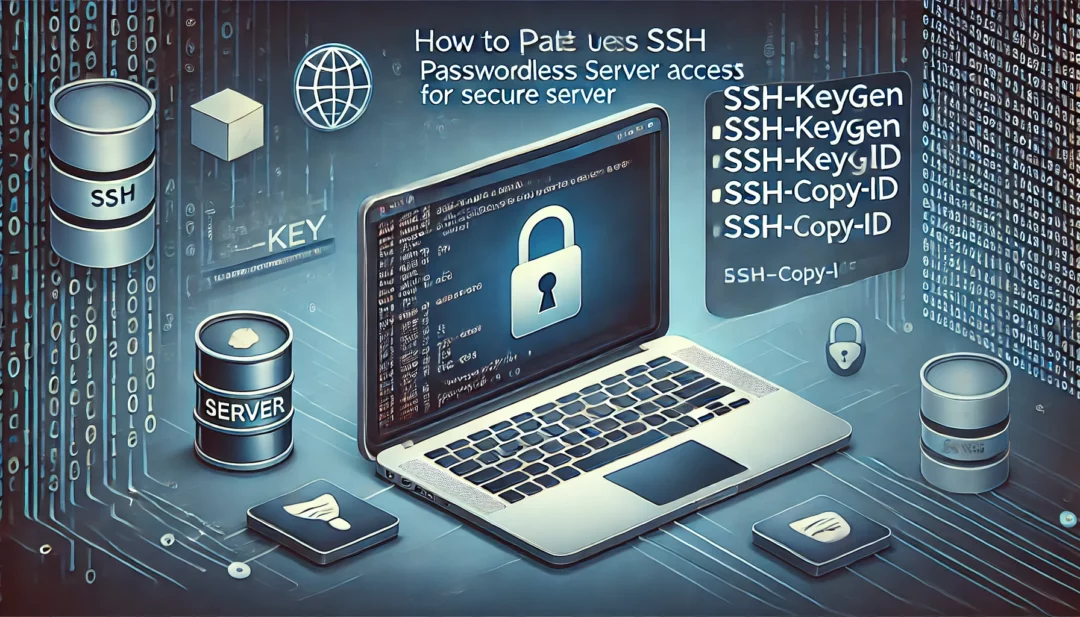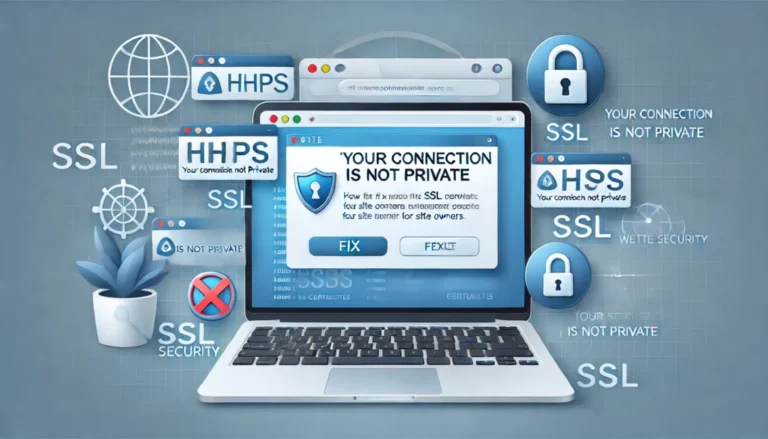
Tired of typing your password every time you connect to a remote server? Setting up passwordless SSH simplifies your workflow and enhances security. By using SSH keys, you can authenticate seamlessly without compromising control. It’s a straightforward process that saves time and effort.
To get started, you’ll generate an SSH key pair on your local machine. Next, you’ll copy the public key to the remote server, ensuring it’s placed in the right directory. Finally, you’ll test the connection to confirm everything works as intended. Once done, you’ll enjoy secure, hassle-free access to your servers.
What Is Passwordless SSH?
Passwordless SSH lets you authenticate to a remote server without typing a password each time. It uses an SSH key pair, a cryptographic combination of a private key stored locally and a public key placed on the server. When you initiate a connection, the private key validates against the public key, granting access if they match.
This method enhances security by eliminating password risks like brute-force attacks. It also streamlines workflows, especially in automation or frequent server interactions. Developers, system administrators, and DevOps professionals commonly use passwordless SSH for secure and efficient remote server management.
Benefits Of Passwordless SSH
Passwordless SSH optimizes efficiency and enhances security in remote server management. It reduces reliance on passwords, leveraging SSH key pairs for secure and seamless authentication.
Enhanced Security
Passwordless SSH significantly improves security for remote connections. Using key-based authentication eliminates vulnerabilities associated with passwords, like brute-force attacks or phishing. The private SSH key remains securely stored on your local machine, and only the matching public key on the remote server allows access. This eliminates unauthorized access attempts based on stolen or guessed passwords.
Additionally, passwordless SSH enables compliance with security best practices by mandating strong cryptographic methods rather than weak or reused passwords. For example, developers and system administrators can avoid risks of password sharing across systems while adhering to internal or organizational security policies.
Improved Convenience
Passwordless SSH streamlines workflows by removing the need to manually input passwords repeatedly. This is especially useful if you frequently access servers or automate tasks, such as deploying applications or managing cloud instances.
By enabling authentication with a private key, you reduce authentication time and avoid interruptions caused by typing errors. For example, DevOps teams handling CI/CD pipelines or automated scripts can benefit from quicker, uninterrupted remote operations, increasing overall productivity.
Prerequisites For Setting Up Passwordless SSH
To set up passwordless SSH, ensure you meet specific requirements and have the necessary tools ready. Proper preparation ensures a seamless configuration process.
SSH Client And Server Requirements
Install an SSH client on your local system, such as OpenSSH, as it’s required for generating and managing SSH keys. Most Linux and macOS systems include OpenSSH by default, but you can install it manually using your package manager if missing.
Verify the SSH server is active on the remote machine. Use the appropriate command for your system, like sudo systemctl status ssh on Linux, to confirm it’s running and listening for connections. For Windows servers, install and configure OpenSSH or an equivalent SSH server.
Generating SSH Key Pair
Generate an SSH key pair to enable passwordless login authentication. Run the command ssh-keygen -t rsa -b 4096 on your local system. The -t option specifies the RSA algorithm, while -b defines the key length.
When prompted, specify a file location for the private key or press Enter to use the default path (~/.ssh/id_rsa). For added security, set a passphrase or leave it empty for automation purposes. This generates two files: a private key (id_rsa) and a public key (id_rsa.pub).
Keep your private key secure. Avoid sharing it, and store it with appropriate file permissions on your local machine (chmod 600 ~/.ssh/id_rsa). Use only the public key for server configuration to maintain security.
How To Setup Passwordless SSH
Setting up passwordless SSH enhances security and streamlines access to remote servers. Follow these steps to configure passwordless SSH using an SSH key pair for seamless authentication.
Step 1: Generate SSH Keys
Generate an SSH key pair on your local machine to enable key-based authentication. Use the following command in your terminal:
ssh-keygen -t rsa -b 4096
This command creates a 4096-bit RSA key pair for increased security. You’ll be prompted to set a file location to save the key pair and an optional passphrase for the private key. Press Enter to use the default file path and leave the passphrase blank for passwordless access. Two files, id_rsa (private key) and id_rsa.pub (public key), will be generated in the specified directory.
Step 2: Copy Public Key To Server
Transfer the public key to the remote server to authenticate. Use the ssh-copy-id command, which automates the key transfer process:
ssh-copy-id username@remote_server_ip
Replace username with your server account’s username and remote_server_ip with the server’s IP address. After running the command, enter the password for the remote server account. The public key (id_rsa.pub) is appended to the ~/.ssh/authorized_keys file on the server.
If ssh-copy-id isn’t available, manually copy the key using cat and ssh:
cat ~/.ssh/id_rsa.pub
|
ssh username@remote_server_ip "mkdir -p ~/.ssh && cat >> ~/.ssh/authorized_keys"
Ensure the ~/.ssh directory and authorized_keys file have the correct permissions:
chmod 700 ~/.ssh
chmod 600 ~/.ssh/authorized_keys
Step 3: Configure SSH Settings
Modify SSH client settings for optimized performance. Open the SSH configuration file on your local machine:
nano ~/.ssh/config
Add these lines to specify default options:
Host remote_server_alias
HostName remote_server_ip
User username
IdentityFile ~/.ssh/id_rsa
Replace remote_server_alias, remote_server_ip, and username with your preferred alias, the server’s IP address, and your username. Save and close the file. This setup allows you to connect using ssh remote_server_alias instead of entering the full details each time.
Step 4: Test The Passwordless Connection
Establish an SSH connection to confirm the setup:
ssh remote_server_alias
If configured properly, you’ll gain access without entering a password. Verify file permissions if authentication fails. The private key must remain secure with correct settings (chmod 600 id_rsa), and the server must have the appropriate authorized_keys configuration.
Troubleshooting Common Issues
Encountering problems during setup can disrupt the effectiveness of passwordless SSH. Addressing these issues ensures your connection is secure and functional.
Permission Denied Errors
“Permission denied” errors generally indicate problems with key placement or file permissions. Verify these steps to resolve the issue:
- Check Public Key Placement
Ensure the public key is correctly added to the ~/.ssh/authorized_keys file on the remote server. Use this command to view the contents:
cat ~/.ssh/authorized_keys
If the key isn’t listed, re-add it using ssh-copy-id or manual copy methods.
- Verify File Permissions
Incorrect permissions for SSH files and directories often cause denial errors. Ensure the following:
- The
~/.sshdirectory has700permissions:
chmod 700 ~/.ssh
- The
authorized_keysfile has600permissions:
chmod 600 ~/.ssh/authorized_keys
- The private key file (
id_rsa) on the local machine has600permissions:
chmod 600 ~/.ssh/id_rsa
- Match Server Username
A mismatch in usernames can trigger this error. Log in using the correct format:
ssh [username]@[remote_server]
Replace [username] and [remote_server] as needed.
Wrong Key File Configuration
Misconfigurations in SSH key files can lead to failed authentication. Follow these steps to troubleshoot:
- Verify the Correct Private Key Path
Ensure your SSH client is using the intended private key. Explicitly specify the key file using:
ssh -i ~/.ssh/id_rsa [username]@[remote_server]
- Check SSH Agent Setup
If using an SSH agent, ensure the key is added. Run the following commands:
- Check for active keys:
ssh-add -l
- Add the key if missing:
ssh-add ~/.ssh/id_rsa
- Inspect Key File Format
Ensure the private key file is in the correct format. Valid private keys should start with -----BEGIN OPENSSH PRIVATE KEY-----. Recreate the key pair using ssh-keygen if the format appears incorrect.
Addressing these common issues restores functionality, ensuring secure, passwordless SSH connections.
Best Practices For Passwordless SSH Usage
Follow these best practices to maintain security and efficiency while using passwordless SSH. Proper implementation ensures effective server management and minimizes risks.
Use Strong Encryption Algorithms
Ensure your SSH keys use robust encryption like RSA (2048 or 4096 bits) or ED25519. Strong encryption prevents brute-force attacks and ensures secure communication.
Secure Your Private Key
Store private keys in a secure location, such as ~/.ssh/, and set file permissions to 600 using chmod 600 ~/.ssh/id_rsa. Restrict access to unauthorized users to protect sensitive data.
Enable SSH Agent Forwarding Only When Necessary
Activate SSH agent forwarding sparingly for securing connections between multiple servers. Verify you’ve disabled forwarding when not required to prevent potential key exposure.
Regularly Rotate SSH Keys
Generate new key pairs periodically and replace existing ones to comply with security policies. Rotate keys immediately if you suspect unauthorized access or key compromise.
Use Passphrases For Private Keys
Add a passphrase to private keys during key generation. Passphrases provide an additional layer of security, ensuring access even if the private key is stolen.
Limit User Access
Restrict SSH access to specific users who require it. Modify the AllowUsers or AllowGroups directives in the server’s SSH configuration file (/etc/ssh/sshd_config) for tighter control.
Disable Root Login
Disabling root login strengthens server protection. Edit PermitRootLogin in sshd_config to no to force users to log in with individual accounts before escalating privileges.
Monitor SSH Logs For Suspicious Activity
Regularly review server logs, such as /var/log/auth.log or /var/log/secure, for failed login attempts or unauthorized key usage. This aids in early detection of security breaches.
Use Fail2Ban Or Similar Tools
Implement intrusion prevention tools like Fail2Ban to block repeated login attempts. Configure it to monitor SSH and ban IPs exhibiting suspicious behavior.
Avoid Sharing Private Keys
Ensure each user generates their own SSH key pair. Never share private keys across individuals or devices to avoid introducing security vulnerabilities.
Backup SSH Configuration Settings
Maintain backups of essential SSH configuration files (e.g., ~/.ssh/config and /etc/ssh/sshd_config). Backups provide recovery options in case of configuration errors or corruption.
Test Configuration Changes
Validate updates to SSH settings using a test connection before fully deploying them. Testing prevents accidental lockouts or server access disruptions.
Conclusion
Setting up passwordless SSH is a game-changer for secure and efficient server management. By leveraging key-based authentication, you can eliminate the hassle of repetitive password entry while enhancing security against common threats like brute-force attacks.
With the right setup and adherence to best practices, you’ll streamline your workflows, reduce risks, and ensure a seamless connection to your remote servers. Whether you’re managing automation tasks or accessing servers frequently, passwordless SSH provides the reliability and convenience you need to stay productive and secure.
Frequently Asked Questions
What is passwordless SSH?
Passwordless SSH is a secure authentication method that allows remote server access without requiring a password. It uses SSH key pairs—one private key stored locally and one public key placed on the server—to validate connections.
What are the benefits of passwordless SSH?
Passwordless SSH simplifies workflows by removing the need to repeatedly enter passwords and enhances security by eliminating risks like brute-force attacks and phishing.
How do I generate SSH keys for passwordless SSH?
Use the command ssh-keygen -t rsa -b 4096 to generate an SSH key pair on your local machine. The private key stays secure on your device, while the public key is uploaded to the server.
How do I transfer my public SSH key to the remote server?
You can transfer the public key using the ssh-copy-id user@server command. Alternatively, copy it manually to the ~/.ssh/authorized_keys file on the server.
What should I do if I get a “Permission denied” error?
Ensure the public key is correctly placed in the ~/.ssh/authorized_keys file on the server and that file permissions are correctly configured. Verify the username and key file path as well.
Is passwordless SSH safe?
Yes, passwordless SSH is safe when configured correctly. Use strong encryption algorithms, secure your private key with a passphrase, and regularly rotate your SSH keys for additional security.
Can I use passwordless SSH for automation?
Absolutely! Passwordless SSH streamlines automation by removing the need for manual authentication, making it ideal for tasks like deploying code or automating server maintenance.
What are the best practices for securing passwordless SSH?
Use strong encryption, restrict user access, disable root login, monitor SSH logs, rotate keys regularly, and avoid sharing private keys. Also, back up your SSH configurations and implement intrusion prevention tools like Fail2Ban.
How can I test if my passwordless SSH setup works?
Run ssh user@server. If configured properly, you should connect without being prompted for a password, verifying the passwordless setup is functional.
What tools are required to set up passwordless SSH?
You’ll need an SSH client (e.g., OpenSSH) on your local machine and an active SSH server configured on the remote system. These are standard for most Linux-based environments.
Why are file permissions important in passwordless SSH?
File permissions ensure only authorized users can access private keys and authorized_keys. Incorrect permissions can lead to security vulnerabilities or prevent the setup from working properly.
Should I use a passphrase for my private key?
Using a passphrase is recommended for added security, especially if the private key stores sensitive server access information. It protects your key in case of device theft.
Can I disable SSH password-based authentication?
Yes, and it’s a good security practice. Modify the SSH server settings in the /etc/ssh/sshd_config file by setting PasswordAuthentication no.
What if I lose my private SSH key?
If you lose your private key, you’ll need to generate a new SSH key pair and replace the old public key on the server. Keep backups of configurations to avoid lockouts.
How can I monitor suspicious SSH activity?
Regularly check SSH logs using commands like sudo cat /var/log/auth.log on Linux. Look for repeated failed login attempts or unknown IP addresses attempting connections.






